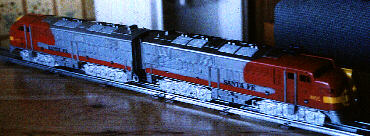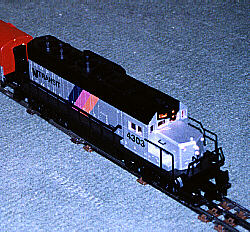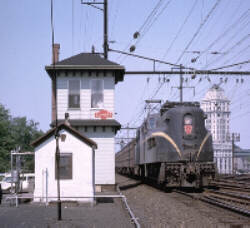
Copyright 2002 T. Sheil & A. Sheil All Rights Reserved
The classic Yule scene often depicts a train running under the Tree. Back in the 1920s and 1930s, that would either be Standard gauge or O / O27. Today, it can be any number of trains and sizes. The problem is: what train is best for you?
Maybe you are one of those lucky families that has an 'heirloom train." This is a train that has been in the family a long time. Maybe it was your train from childhood, or your father's, grandfather's or ever great grandfathers'. Maybe it was a gift. Heirloom trains are a wonderful thing. Not only that: I have several articles just for you to keep that train in good running shape. (They are on our main page).
Maybe your train is one you bought, for whatever reason. It looked nice, the price was right, or it was the only train in the store. Again, we have all you need to know about its technical side on our main page.
But maybe you are going to buy a train, or are considering it as an option. Here are a few things to add into the equation while you ponder it:
First, we are talking about a train for the holidays. It is not a hobby, per se, although it might grow into one. Then again, it might not. What you want primarily is a train for the holidays. Unlike trains owned by serious hobbyists - myself included - there are other considerations. Paramount among them are the space you have and what the train will have to endure.
Electric trains are sold by size. The size is a matter of "scale" and "gauge." Scale is the relationship in size of the train to the real world. For instance, an O scale train is 1/48 the size of a real one; and HO scale train is 1/87 the size. Gauge is the distance between the rails. The gauge of O track is 1 1/4", while the gauge of G track (also called #1 gauge) is 1 3/4". Whether a train's size is given in gauge or scale is not an issue for holiday layouts.. Scale or gauge are mainly the concern of model railroaders.
The size of trains is given by a letter system. The common sizes are G, Standard Gauge, O, O27, ON30, S, HO, and N. There are other sizes, but they are less common. of these, G trains tend to be the largest, and N the smallest common scales. The train's size is important, depending on the amount of space you have and the amount of handling the train will get.
If you have small children, pets, and / or clumsy relatives visiting, you need a sturdier train. O27, Standard Gauge and American Flyer S gauge are the sturdiest trains ever made. They were originally designed for kids. G is also very durable. ON30, HO and N tend to be more delicate. Also, smaller trains make attractive targets for some pets. An N scale locomotive is the same size as a mouse, and HO is the size of a chipmunk. That's what Kitty sees - and believe me, a small house cat can wreak havoc on small trains. Small children are equally hazardous. You also have the problem of delicate, small parts that break off very easy. If you have wee ones toddling about, forget placing ON30, HO or N in their reach. Trains are very attractive to small children.
The price of trains is a poor indicator of their suitability for holiday displays. Expensive trains tend to be festooned with delicate details, hence the higher price. The same details which makes them desirable for hobbyists and drives up the price are the very things you might not like for a holiday display. They are more pieces to break. A $200 HO locomotive will not outlast a $50 one on a busy holiday pike with small hands clutching at it. .The $1,000 O Gauge locomotive would be at a loss in holiday service, while the $150 starter set would be just right because it is very sturdy and has fewer parts to break. For now, let's forget price and look at other factors.
Space is at a premium for most people. If you are running them under the tree, you have to account for the space used by the tree stand as well as how much space you can use around it. Some do not run under the tree, but set up a separate display on a shelf or table. Again, space counts.
Every scale and gauge has standard sizes for track. The thing you need concern yourself with is the size of curves. This is rated in radius for HO, N and S. In O, O27, G and Standard Gauge it is given in diameter. For tight spaces, you need to use track with the tightest curve radius / diameter. The radius / diameter tells you how much space a full circle of track would use. Here are minimum radii and diameter track curves for the common train sizes
| Scale / gauge | Diameter | Radius |
| G | 4 feet | 2 feet |
| Standard Gauge | 42 to 44 inches | 21 to 22 inches |
| O Gauge | 31 inches | 15.5 inches |
| O27 | 27 inches | 13/5 inches |
| S Gauge | 38 inches | 19 inches |
| HO and ON30 | 36 inches | 18 inches |
| N | 19.5 inches | 9 3/4 inches |
Note some variations in track, so depending on the brand, it might take and inch or so more or less.
If your entire space is 3' by 3', you can use O, O27 and N. It might be a tight squeeze for HO and ON30.
If your entire space is 4' by 4', you can use them all. However, it might be a tight squeeze for G scale
At 5' by 5', you can have a loop of any of these scales and gauges.
Note that for more elaborate layouts, you need more space. Our Holiday Layouts were designed for use under the tree. We have other layouts on the main page which can be used if your layout is not under the tree.
You would want a train that is sized for your buildings and scenery, If you are using scenery and buildings sized like the trains, then a match is easy. Otherwise, there are more things to consider.
The buildings by Lemax, Department 56 and others are mainly in the 1/64 to 1/48 range. A rare few are scaled larger. They are closest in scale to O, O27, ON30 and S gauge trains. The miniature people sold by Lemax and Department 56 tend to be about 60mm scale, which is closest in scale to G and Standard Gauge. A G scale train will dwarf most Lemax and Dept 56 buildings. We have found that for Tinscale, the ceramic buildings in the 1/64 to 1/48 region work best with O, O27. ON30. S and Standard gauges. Keep in mind that a Standard gauge train is smaller than G, yet larger than O. It is large enough to be compatible with the miniature people, and though it outshines buildings, it does not dwarf them the way G scale does.
To model railroaders in North America, O has two meanings. It is a scale of 1/48 and a gauge of 1 1/4" Traditional O Gauge is not exactly to scale. It is a large, robust train that will handle a 31" diameter curve. When people think of O, they think of the traditional O Gauge makers from the 50s, Lionel and Marx.
O27 is a track that is O gauge, but uses a tighter 27" diameter curve. O27 trains tend to be slightly smaller than regular O. They are the ones most commonly sold as train sets for O gauge. O27 costs a bit less, but is just as sturdy as O. Its smaller size and fewer details make it less expensive.
ON30 is an O scale train that runs on HO gauge track. It is based on what they call "Narrow Gauge." In real Narrow Gauge railroads,the track gauge is narrower than that found on mainline railroads. Standard railroad gauge is 4 feet 8 1/2 inches. Narrow Gauges run on gauges such as 3 feet or two feet. The ON30 models are not as big as O Gauge because in the real world, Narrow Gauge locomotives and cars are smaller than those used on main line railroads. ON30 uses HO track and has HO type motors and wiring. It is more delicate then O27 because it is meant to be a more accurate miniature.
For holiday running, O27 is a good, reliable train that can withstand a lot of handling. O27 has the advantages of using a tighter curve and having a much lower price than O. ON30 is a delicate model train made to look realistic, at the expense of sturdiness. ON30 trains all tend to be models of old time types made between1860 and 1910. Being smaller, they can be submerged into a village scene, if that is what you desire. O27 is larger and more notable ,and cannot be submerged. It is a highly visible element. Likewise, if you use large figures with your village, they will fit better with O27 than with ON30. The Narrow-gauge ON30 looks better if you use small figures scaled to fit the buildings.
When buying supplies for these trains, O and O27 use O Gauge goods. ON30 uses ON30 trains, but its track, power supplies, etc. are the same as HO.
Lemax and some other companies had their own trains. These are not like regular model trains and are not compatible. In fact, they are often too small in scale. Your best bet is to use the standard electric trains rather than "house brands" like Lemax/ Also, Department 56 sells its own version of the ON30 trains. They are identical to Bachmann, but painted differently and sold under the Dept. 56 name. You would do better to acquire hobby trains from regular hobby sources. you will find more reasonable prices, better compatibility and therefore easier access to supplies, repairs, etc.
You get what you pay for, providing you know what you are buying. O, O27, Standard Gauge and S Gauge are very sturdy, very reliable, and more expensive. A starter set for O27 runs between $150 and $250. Of course, with a little care it can last for decades. A G set can run about the same for brands like Aristocraft and Bachmann, and much higher for LGB. ON30 runs between $125 and $150. Standard gauge starts at over $500 per set. It is sturdy, big and reliable, but very expensive!
Starter sets for Ho and N run from $40 to about $100. The problem is that most small-scale starter sets are cheaply made. They have none of the detail or features of the better lines of trains, and are sold merely as a cheap train. Hobbyists in HO and N have low regard for them. You might think you are being frugal with them, but they are easily broken and are not built to last.
American Flyer S gauge is no longer made as sets. The Flyer sets out there are older ones from the 1950s and 1960s, and they generally run from $300 on up. Two new makers of S Gauge, S Helper and American Models, are very expensive. Their sets start in the over - $300 range.
Battery-operated trains are sold as toys. Though some of the G sets are sturdy and last a while, the smaller O and Ho size battery sets are flimsy and prone to break and wear out. If you must have a battery set, G is the only reliable scale.
Your set should include track, a power supply (transformer) and a train with a powered locomotive and several unpowered cars. It will have instructions for its set-up and use.
Extra track has different prices.
G track tends to run from $3.50 to $5.00 per section.
Standard gauge is about the same.
Old-fashioned O Gauge tubular track, used by Lionel, costs $1/25 to $2.00 per section
O27 tubular track costs 80 cents to $1.00 per section.
MTH's O gauge Real Trax and K-Lines's Super Snap track runs about $3.50 to $5.50 per section. K-line also makes tubular rail comparable in price and quality to Lionel, and it is in both older sets and sold separately.
Plain HO track is about 65 cents to 90 cents per section. Fancy track like Bachmann EZ track and LifeLike Power Loc cost more.
N track is about 50 cents per section ,and somewhat more for EZ Track.
Not all track is equal. Power Loc needs an adapter to connect to other brands of track. The same goes for MTH Real Trax and K-line Super Snap. If you already have track and want to use it, make sure you buy track that is compatible. Fortunately, there is plenty of new HO, N, O and O27 track made that is compatible with older track.
Some folks insist on trains fitting the exact era of their worlds, and some do not. Diesel and electric types do not fit a Victorian scene, and steam locomotives would be mostly out-of-place on a modern pike. Of course, this is Tinscale, so you can use any train you want. If keeping to the era is important, there are some things you should know.
Steam-powered trains were used from the beginning of railroading up until the late 1950s. A few rare pieces lasted longer, but by the mid-1950s most railroads had scrapped steam and replaced it with diesel. Steam locomotives are notable by their shape and attributes. Look at the pictures

Steam locomotives all have a smokestack, normally at the front. They have drive wheels connected by a bar. Atop the round part of the body, which is known as the boiler, are small domes. The cab is to the rear. (A few rare types had cabs in the center, and one odd type had it in front.) Except for small switching steamers, they all have a tender. People who don't know trains sometimes call it a "coal car." It carried coal and water, which are the fuel for the steam locomotive.

Steam locomotive types have nicknames based on their wheel arrangements. The wheels connected by the rod are the drive wheels, or drivers. The non-drivers in front are the pilot wheels. Non-drivers under the cab are trailing wheels. Some trains have no pilot or trailing wheels.
Proper configuration for a steam locomotive is that the engine is in front, tender behind. The tender is connected to the engine by a draw bar.
Diesel locomotives first arrived in the 1930s. They were popular by the late 1940s. There are two eras for diesel, late and early. Early diesels tend to be streamlined types, such as the F unit and Alco. If your layout is in the era from 1940 to 1970, you can use these types.


Electric locomotives first appeared in the early 20th Century. They get their power from overhead wires of a "third rail" placed alongside the track. Trolleys are also powered by an overhead wire.

Even these types of trains come in different eras. Trains from the 1800s tended to be a little smaller and much more ornate. Those used during the early Victorian Era had balloon-shaped smokestacks and brass trim. Those in the late 1800s to the middle of the 20th Century were mostly black and more utilitarian in design. We have also seen two eras of diesel. The trains of the 1950s were mainly sleek "cab units" like the F7 and various working locomotives such as the switcher and RS3. Later diesels are larger and boxier. Locomotives like the GP40 and U-Boat are bigger and tend to be less decorative.
If you have any doubts, ask. Check with the local hobby shop. Ask on some of the railroad forums.
Below are links to other articles on our main website that can help you to better enjoy your trains.
Holiday Layout Plans - track plans for under and around the Yule Tree
Old Trains from the Attic or Basement- If you inherit or discover old trains, learn what type they are and how to run them.
Trains for the Holidays - finding the right trains, for gifts or for yourself
Yule Tree Safety - better ways to run trains under the Tree.
Starting with Trains - ideas for those new to the hobby
Make a Holiday Display Layout - step-by-step info on making a small scale holiday display layout
Click here to return to All Gauge Model Railroading main page